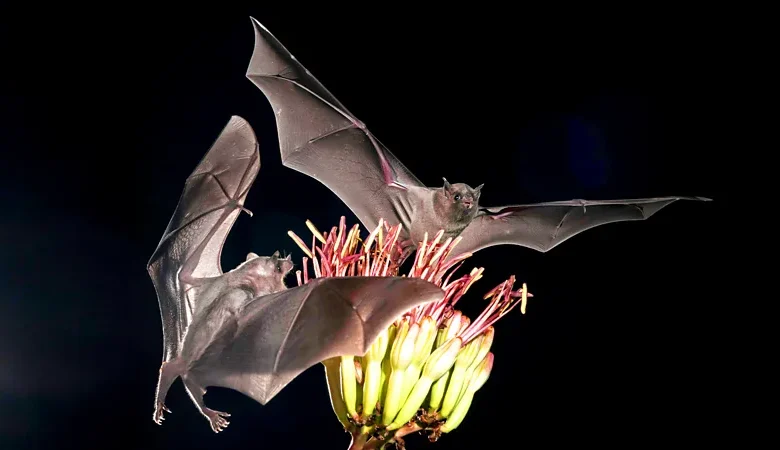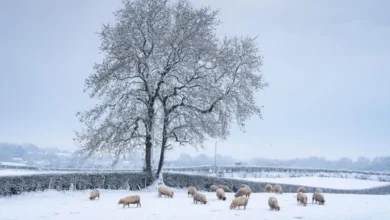Why tequila depends on Mexico’s bats

Conservationists and communities are planting thousands of agave plants to protect endangered bats, as well as the future of Mexico’s tequila production.
In the dusty expanse of central Mexico’s Chihuahuan Desert, chill, dark caves are hidden in the brown rocks. Inside them, during late Spring, are thousands of small, furry bats. Most of them are female and pregnant – and they’ve set off on a 1,000 mile (1,609km) journey from southern Mexico to the southwest of the US, where they’ll give birth. They’re hungry and fly for hours at night to find enough food. They flap from plant to plant, collecting nectar and spreading pollen as they go.
Among their favourites are the fluffy yellow flowers of the agave plant – flowers that appear just once in the plant’s decades-long lifetime. These spiky, fleshy-leaved agave plants have a long history in Mexican culture. They’re used to make syrup, rope and soap, and their juice is the main ingredient in one of Mexico’s most iconic exports: tequila.
But wild agave plants are declining: in a study of 168 species, 42 are now threatened or severely endangered. This means less food for bats that depend on their flowers – and fewer bats in turn means that fewer agave plants are pollinated. To break the cycle, conservationists are working with locals to plant thousands of agave plants – helping feed the bats and protect the future of Mexico’s tequila production.
One agave-dependent bat species – the lesser long-nosed bat – has seen a remarkable population recovery in recent decades, multiplying from 1,000 in 1988 to an incredible 200,000 today. But others are not doing so well. The Mexican (or greater) long-nosed bat has declined by an estimated 50% over the past two decades and is currently endangered. Another species, the Mexican long-tongued bat, has near-threatened status.
Biologist Marco Antonio Reyes Guerra is part of the Bat Friendly Project at the National Autonomous University of Mexico, which works with farmers to encourage agave farming that supports bats. He explains that many of the threats faced by bats are caused by humans. “If they have some disturbance in the caves, they are going to abandon the caves and they are going to lose their home. And people are deforesting several areas of dry forest, and in that forest there are species that bats use as a food source.” These species include agaves, as well as other plants that the bats feed on.
Scientists at Bat Conservation International (BCI) are determined to turn things around for these declining species. The Agave Restoration Initiative involves planting and protecting wild agaves in the ‘nectar corridor’ the bats follow on their migration. “The whole thing was started because, once these migratory species leave central Mexico, they heavily depend on agaves,” says Ana Ibarra, a bat biologist and regional director at BCI.
Wild agaves are facing their own threats: they’re harvested to make spirits, grazed on by cattle, losing their habitat to agriculture, and facing drier conditions due to climate change – and, because there are fewer bats, the plants are pollinated less often. Agaves rely on bats for reproduction just as much as the hungry bats depend on agaves for food.
“Bats and agaves have coevolved over several millions of years,” Reyes Guerra says. Long-tongued and long-nosed, the bats can reach into the agave’s narrow cone-shaped flowers to feed, and to collect pollen on their face and fur. “If the bats are not present in an ecosystem, the agaves probably will not produce any seeds to reproduce, because agaves only reproduce once in their lifetime.”
Without any kind of intervention, and in the face of climate change, scientists estimate that threatened bat species will have 75% less access to agave nectar by 2050 than they do today.
For conservation efforts to work, agaves need to have a chance to grow old enough to flower – not only for the bats’ sake, but their own. Farmers who grow agave for tequila often cut the stalk to prevent flowering, resulting in a larger ‘heart’ (or piña) for harvest. Rather than reproduce through pollination, these plants produce ‘pups’ that are genetic clones of their parent plant. This reduces the species’ genetic diversity, making it less resilient to the drier conditions that come with climate change, as well as pathogens and pests. “It’s an important risk for the agave and mezcal industry,” Reyes Guerra says. Ultimately, to survive as a species, agaves need pollination.
“Without the bats, tequila and mezcal wouldn’t even exist,” Reyes Guerra adds. “If people want to keep drinking tequila and mezcal, they have to take the bats into account, they have to be concerned about conservation.”
Since the Agave Restoration Initiative launched in 2018, the team and local communities have planted more than 180,000 native agave plants and have over 150,000 more growing from seed in nurseries in Texas, Arizona, New Mexico, and across Mexico.
Reyes Guerra’s bat friendly tequila and mezcal project is also working to increase the number of yellow agave blooms across southwestern Mexico. Participating farmers allow at least 5% of their agave plants to mature and flower, so passing bats can feed. Spirits produced by that farm are considered ‘bat friendly’ – and, so far, 300,000 bottles of ‘Bat Friendly’ tequila and mezcal have been produced.
If people want to keep drinking tequila and mezcal, they have to take the bats into account and be concerned about conservation – Marco Antonio Reyes Guerra
It’s not only farmers that are shaping the future for bats and agaves. In Mexico, 53% of the land is community-owned, which means that any conservation effort must involve everyone who lives on the land. “Since the beginning, it was very clear we must work with the communities and try to meet the needs of both bats and people,” says Ibarra.
The first step has been to teach people that the nectar-feeding bats aren’t harmful. People often think they are vampire bats, which can carry rabies. According to Ibarra, some locals will burn caves with bats in them “without knowing whether they were actually vampire bats”.
Lissette Leyequien is the director of Área de Protección de Flora y Fauna Sierra La Mojonera, a federally protected natural area in Mexico that is collaborating with the Agave Restoration Initiative. She works closely with locals to change people’s perception of bats.
“In the past, the people hated bats and they tried to kill all the bats they saw,” she says. But today, following the education programme provided by BCI, people are actively protecting the caves. “They don’t allow people to go inside and do anything that can hurt the bats. Almost all the people really love bats. They realise that the bat is a very good provider of many benefits,” Leyequien says.
Six important Mexican long-nosed bat roosts are now actively protected by local communities across Mexico, and the initiative’s education programme has reached over 1.5 million people.
Reyes Guerra agrees that bat conservation starts with locals. “You cannot do conservation without taking into account the local people, and consulting them to take decisions – because they sometimes have really valuable information that we, as scientists, don’t know,” he says. Reyes Guerra had recently, for example, been guided to a tiny, difficult to access cave that housed five bat species. “This is really, really rare to find,” he says.
The real impact of recent conservation efforts won’t be felt for some years though, because the agaves need time to grow. But thanks to both BCI and the Bat Friendly Project, people are letting more of the existing agave plants mature and flower. “You can see patches of flowering agaves in areas [where] you used to see nothing [because people] are now leaving the flowering stalks for the bats,” Ibarra says.
Already, Ibarra has observed the number of bat babies increasing. “These increments are not big jumps, but they’re steady,” she says. “When you’ve seen steady decline, just keeping the numbers stable is a huge win.”
Leyequien has noticed that where the agaves have been planted, the landscape is beginning to look a little greener. “You can see a lot more fauna because they have food, they have places to hide.”
An abundant, flowering agave nectar corridor is still some time away. But even then, Reyes Guerra highlights that the bats will need more help. “The problem with only reforesting with agaves is that bats feed on several species. So, if we only plant agaves to feed the bats, it’s not going to be enough.” Other important species include ceiba trees, ipomoea trees and cactuses like saguaros.
Restoring the agave population is just the first step in creating a healthy ecosystem where more plants, and more bats, can thrive. People are a crucial part of this ecosystem, Leyequien says – and they benefit when the bats are healthy. “Taking care of the bats here works for the people and for the ecosystem. In reality, it’s all connected.”
And if a life lived well includes tequila – whether as farming income, or an evening tipple – then a desert landscape filled with squeaking, swooping creatures and flourishing, flowering life benefits us all.









